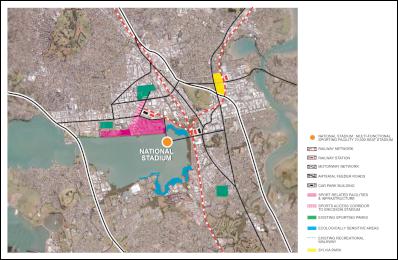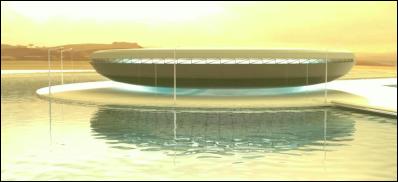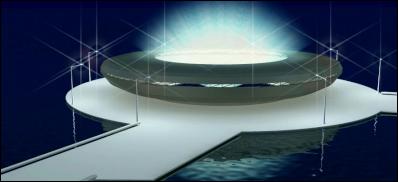Architects Propose Dramatic National Stadium
Auckland Architectural firm, Bossley Copeland Architects, have released their vision to build a state of the art waterfront stadium on Manukau Harbour for the 2011 Rugby World Cup, with a long-term focus looking well beyond 2011.

Click for big version
Barry Copeland and Pete Bossley, along with a team of environmental engineers, town planners and construction advisors, have designed their stadium on Auckland’s Manukau Harbour, close to the portage route which originally linked the two harbours and which has great historical significance for the area.

Click for big version
The award winning architects have come up with a dramatic contemporary design, which is still at concept stage, which would use the latest state of the art technology and lightweight materials to “showcase New Zealand design.” It would become an iconic landmark on the flight path as aircraft descend into Auckland.

Click for big version
Pete Bossley and Barry Copeland believe the site has compelling advantages over other suggested sites. The advantages are:
The site over water is a “blank canvas.” In other words, land does not have to be purchased, existing facilities demolished, or the impact considered on surrounding buildings;It is close to a major transport corridor, with easy access to rail, motorways and Auckland International Airport;
It would bring much needed tourism and business regeneration to the area;
It is close to one of the fastest growing regions in Auckland: Counties and Manukau.
The close proximity to major transport connections and the relative lack of site restrictions will assist with the intended completion of the purpose-designed world class stadium in time for the Rugby World Cup in 2011.

Click for big version
The 60,000–70,000 seat National Stadium would accommodate multiple sporting codes including athletics, cricket, and equestrian, as well as concerts, cultural and special events and conferences. Seating would be flexible so that it could be removed to accommodate varying sporting or cultural events.
Between the stadium and the existing Mt Smart stadium nearby, Copeland and Bossley envisage an axis for the future development of a regional sports campus similar to the Olympic Sports Park in Sydney, Australia. The architects believe their proposal offers key cost, time and environmental (light, noise, transport) advantages in comparison with other proposals currently under consideration. In addition, the stadium would energise the urban regeneration of the whole local area, offering huge long-term benefits to local communities in terms of tourism, employment, education and commercial growth.
Local Iwi have responded positively to the proposal, with Eru Thompson, of Te Iwi Tainui, stating that the proposed plan would “catapult the region” into attracting new industry and redevelopment.
- Ends -
Notes to Editors:
Pete Bossley is an award winning architect and is President of the Auckland Branch of the New Zealand Institute of Architects. Bossley was one of the principal architects of the Museum of New Zealand, Te Papa Tongerewa.
Barry Copeland is an award winning architect who studied at Manchester University and as a young architect worked alongside renowned British architect, Sir Norman Foster. He was a partner in Central London firm, Building Design Partnership, responsible for large-scale industrial and commercial projects, and moved to New Zealand in 1993. He specialises in sports architecture, and recently completed the first stage of Auckland Netball Centre in Mt Wellington, and is currently working on the major extensions of the Auckland Tennis Centre in Stanley Street.


 KiwiRail: Auckland Rail Network Reopens After Successful Upgrades
KiwiRail: Auckland Rail Network Reopens After Successful Upgrades ChargeNet: EV infrastructure co-funding model welcomed
ChargeNet: EV infrastructure co-funding model welcomed NZ Trucking Association: TruckSafe New Zealand Launches | A Game-Changer For Heavy Vehicle Safety And Compliance
NZ Trucking Association: TruckSafe New Zealand Launches | A Game-Changer For Heavy Vehicle Safety And Compliance Gaurav Mittal, IMI: How Can We Balance AI’s Potential And Ethical Challenges?
Gaurav Mittal, IMI: How Can We Balance AI’s Potential And Ethical Challenges? Science Media Centre: Several US-based Environmental Science Databases To Be Taken Down – Expert Reaction
Science Media Centre: Several US-based Environmental Science Databases To Be Taken Down – Expert Reaction Consumer NZ: Despite Low Confidence In Government Efforts, People Want Urgent Action To Lower Grocery Bills
Consumer NZ: Despite Low Confidence In Government Efforts, People Want Urgent Action To Lower Grocery Bills